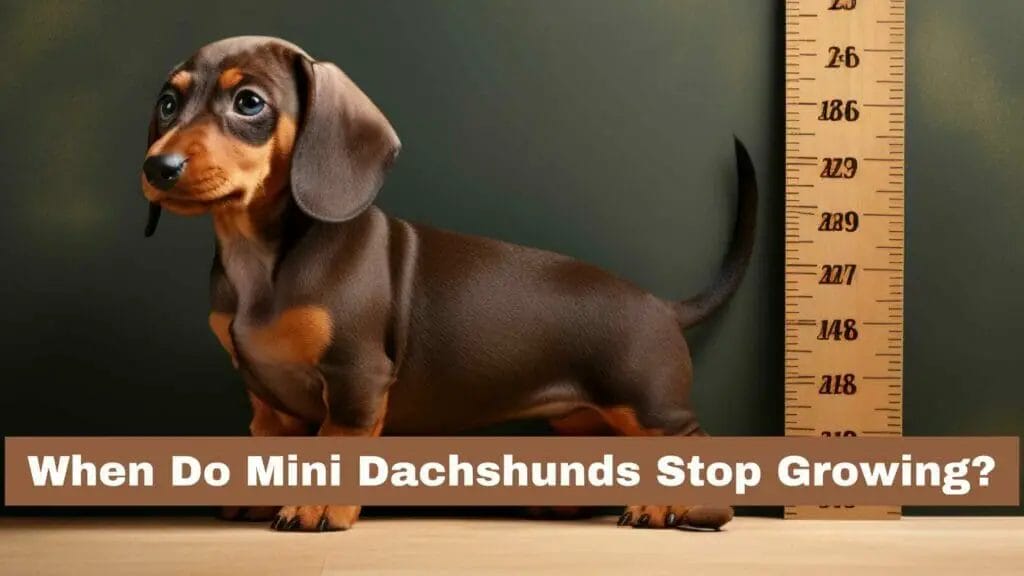
When Do Mini Dachshunds Stop Growing?
Miniature Dachshunds, known for their unique appearance and lovable personalities, has captured the hearts of many dog owners worldwide. As a proud Mini Dachshund owner or enthusiast, you might be curious about when these adorable pups reach their full size and stop growing.
Understanding your fur baby’s growth stages is crucial to ensuring they maintain a healthy weight and lifestyle throughout their lives.
Mini Dachshund Growth Stages
Miniature Dachshunds go through three growth stages:
- Puppyhood.
- Adolescence.
- Adulthood.
Puppyhood
During the first stage of their life, Mini Dachshund puppies will experience rapid growth and development. This puppyhood phase typically lasts until they’re four to six months old.
As a Mini Dachshund owner, it’s essential to provide your pup with proper nutrition and exercise during this critical time to ensure healthy growth.
In these early months, you’ll likely notice how quickly your Mini Dachshund is changing – both in appearance and behavior. Their little legs are getting stronger by the day while their adorably long body starts to take shape.
Regular check-ups with a veterinarian are key during this stage to monitor progress and address any potential health concerns as they arise.
Adolescent
As your mini Dachshund enters adolescence, typically around six to nine months of age, you’ll start to notice some significant changes in their growth and behavior. During this stage, they will gradually transition from a playful pup into a more mature dog.
During the adolescent phase, most miniature dachshunds will reach their adult weight and height by about eight months old. This may vary between individual dogs due to factors such as genetics or environmental influences but generally falls within the range of 11-13 months old.
Nearing the end of this stage, your mini Dachshund may still be growing slightly or filling out in terms of muscle development; however, major growth spurts become less frequent after about nine months old.
Be sure not to overfeed them at this time since young dogs are prone to gaining excessive weight if given too much food, which could cause long-term health issues down the line.
Adulthood
In the adulthood stage, a mini Dachshund has fully developed into their adult size and weight – typically achieved by the time they turn one year old. At this point, your canine companion will likely weigh between 11 and 16 pounds, standing around 5 to 6 inches tall at the shoulder.
During adulthood, maintaining a healthy lifestyle becomes vital for your mini Dachshund as they are no longer growing but still require proper care. Providing them with balanced nutrition, regular exercise routines, and periodic checkups with their veterinarian helps ensure their well-being in the long run.

Factors Affecting Mini Dachshund Growth
Factors that affect the growth of miniature Dachshunds include:
- Genetics.
- Nutrition.
- Exercise.
Genetics
When it comes to Miniature Dachshund growth, genetics plays a crucial role in determining its final size. Both miniature and standard Dachshunds are genetically the same breed, with gene variations influencing things like color and size.
For example, mini Dachshunds have genes for dwarfism that cause their legs to grow slower than the rest of their bodies. This results in a longer body compared to other dachshunds with regular-sized legs.
Additionally, there is a copied gene that gave dachshunds their distinctive elongated bodies, which can affect their growth rate and potential adult sizes.
Nutrition
As a Dachshund owner, it’s important to feed your pup with the right nutrients. Nutrition plays a significant role in the growth and development of Miniature Dachshunds.
One way to ensure that your furry friend gets proper nutrition is by choosing high-quality dog food. Look for premium brands that contain real meat as their primary ingredient rather than fillers or by-products.
Additionally, feeding your Miniature Dachshund on a regular schedule can be beneficial for maintaining their weight and overall health. Try not to give too many treats or table scraps as they can quickly add up in calories and lead to obesity in dogs.
Exercise
Exercise is an important factor in the growth and development of Miniature Dachshunds. While it’s commonly believed that excessive exercise can cause back problems in this breed, the truth is that appropriate exercise can help prevent health issues.
As puppies, Miniature Dachshunds should have limited activity to allow their bones and muscles to develop properly. Once they reach adolescence, regular exercise of at least 30 minutes per day is necessary for their physical and mental well-being as adults.
According to studies, genetics, along with diet and proper exercise, impact when a Miniature Dachshund stops growing. Owners should aim to keep their pets’ weight within an ideal range by maintaining consistent feeding schedules while providing proper outlets for energy through activities such as short walks or games of fetch.
Mini Dachshunds Growth Chart
Understanding your Mini Dachshund’s growth pattern can help you monitor their development and make informed decisions about their care. Here’s a helpful growth chart to track your Mini Dachshund’s progress:
| Age | Weight | Height |
|---|---|---|
| 1 month | 1-3 lbs | 2-3 inches |
| 2 months | 3-6 lbs | 3-4 inches |
| 3 months | 6-8 lbs | 4-5 inches |
| 4 months | 8-10 lbs | 5-6 inches |
| 5 months | 11-13 lbs | 6-7 inches |
| 6 months | 12-14 lbs | 7-8 inches |
| 7 months | 13-15 lbs | 8-9 inches |
| 8 months | 14-16 lbs | 9-10 inches |
| 11-12 months | 11-16 lbs (Full Grown) | 10-11 inches (Full Grown) |
Keep in mind that these figures are only approximate, and individual growth rates will vary based on factors like genetics, nutrition, and exercise. It’s important to remember that Mini Dachshunds typically stop growing in weight and height around their 8th month, with most reaching their full size at around 11 to 12 months. So, don’t fret if your little one stops growing a few weeks sooner or later than the average time – this is completely normal!
When Do Mini Dachshunds Stop Growing?
Miniature Dachshunds typically stop growing at around 11-13 months of age, but their bones will stop growing by the time they’re 12 months old. However, they will keep filling out and putting on weight until they’re 18 months or even two years old.
Average Age For Growth Completion
The average age for mini dachshund growth completion is around eight months old. However, it’s important to note that every dog is different, and some may continue to develop slowly beyond this age.
Signs Of Growth Cessation
Here are some signs that can help determine if your mini dachshund has reached their full-grown size:
- Consistent weighing and measuring shows no significant changes for at least three months.
- Growth plates on the bones have closed.
- The chest of the dachshund is fully formed and broadened.
- The dachshund’s overall shape has filled out, and they no longer look skinny or lanky.
- The Dachshund is reaching their breed’s standard height and weight.
It is important to note that every dog grows differently, so it may be difficult to pinpoint an exact age when your mini dachshund stops growing. However, keeping track of these signs can give you a good indication of when they have reached their full potential size.
Remember to keep up with regular exercise and maintain a healthy weight to prevent any back injuries common in this breed!
